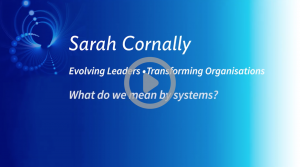
What do we mean by systems?
A system is a collection of elements that are interdependent on each other to serve a purpose – that’s a very simple definition.
There are various terms used in this field, which have different meanings, such as systems thinking, system dynamics, and systemic intelligence.
The term systems thinking has come from the engineering sciences. It’s scientific based, and is about looking at the interaction of dynamics in systems and mapping that. This mapping is very accessible to systems engineers, they can range from very simple to highly complex, but are not particularly applicable for everyday situations especially where there are a lot of indirect cause and effect relationships.
Systems dynamics is really an exploration of what occurs in systems, the relationship between elements and systems. Its origins are in the family systems therapy field, and looks at human systems and humans’ interactions with systems.
Systems thinking and systems mapping are scientific, mind-based approaches. But systems dynamics and systemic intelligence are applied experiences, where we draw on all of our senses, not just our mind. You can almost think of the two areas marrying together and being complementary to each other. The big value of systemic intelligence and systems dynamics is they are used in an applied experience. It can be done intellectually, but the felt sense of how the system is operating is usually much more profound. When we feel something and we have a lived experience of it, we know it differently than if we know it with our mind.
The purpose of systemic work is to understand the system in a way that leads to change, or to movement or action.
So, while a system is simply a composition of elements, system dynamics looks at the interaction within and between systems and the corresponding dynamics. This enables us to influence the system through the intelligence that we gain through our sense perception that we otherwise can’t detect. If we go just with the mind, we can’t detect the invisible aspects. If we go with our body, we can detect the invisible aspects. Those are the differential distinctions that give us new information, new awareness and new insight.
Written by Sarah Cornally
Strategic Leadership Advisor
Cornally Enterprises Pty Ltd
PO Box 4413, Castlecrag NSW 2068 Australia
Fax +61 2 9475 0254









